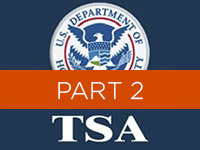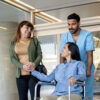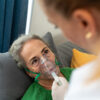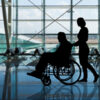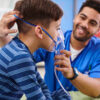As a specialist in door-to-door commercial air medical transports and medical escorts, our staff is trained in how to handle medical interventions during commercial air medical transports. Our area of expertise includes but is not limited to traveling with respiratory equipment, prosthetics, braces, casts and other support appliances. If there are questions about specific medical devices, their safety for in-flight use, and airport screening methods, SentinelMED will handle the research and prepare the necessary medical documentation. The following are TSA regulations that apply to common external medical interventions:
Respiratory Equipment
Traveling with a portable oxygen concentrator can be tricky. Not all airlines allow the use of portable oxygen concentrators during flight. Similarly, not all portable oxygen concentrators are approved for in-flight use. For its patients, SentinelMED ensures that all necessary approvals are in place with the airlines and that a suitable oxygen concentrator is used during the flight. During the pre-flight consultation with patients’ physicians, the SentinelMED team determines if disconnecting from the device is possible (and for how long). If possible, devices that can be detached may be subject to x-ray or advanced imaging screening during the TSA screening. However, if patients must remain connected to the portable oxygen concentrator, the device may be subject to explosive trace testing. During this test, a small white swab is wiped on the machine and analyzed for small amounts of explosives.
Other types of respiratory equipment, including nebulizers, CPAPs, BiPAPs and APAPs, are typically approved by TSA and allowed by all airlines. It’s recommended that these devices be packed in carry-on luggage in clear plastic bags. Facemasks and tubing can remain in their cases, but the device itself will need to be removed from its carrying case and x-rayed. Keep in mind that it’s possible that the device will also be subject to explosive trace testing after being x-rayed. There are certain parts of these machines that are difficult to see on the x-ray screen so a closer inspection may be required.
Prosthetics, Casts, Braces and Support Appliances
Occasionally, patients require medical interventions for amputated or injured extremities, bones or joints. Prosthetics, casts, braces or other support appliances may be needed due to a medical event that occurred while traveling or could be a long-standing part of a patient’s medical history and needs. In either instance, SentinelMED is able to help patients move through the screening process as efficiently and respectfully as possible. Patients may voluntarily remove the prosthesis, cast, brace or support appliance prior to screening so that it may be x-rayed. These medical devices may be subject to additional screening which may require a second removal. Patients may be asked to lift, raise or lower clothing to effectively screen the prosthesis. If the medical intervention is in or around a sensitive area, patients can have a private screening or ask for a drape during the screening process. However, for those who cannot remove a prosthesis, the device may be screened through advanced imaging, metal detector or a pat down exam.
Commercial Air Medical Transports Company
SentinelMED’s team of qualified logistics and medical professionals are able to determine the appropriate form of affordable commercial air medical transport and can help manage the process from end-to-end. As a commercial air medical transport service, we understand the complexity of delivering exceptional care to the sick, elderly, disabled or injured patient who is away from home and in an unfamiliar environment. Please contact us if you’d like to learn more about our services and staff.


